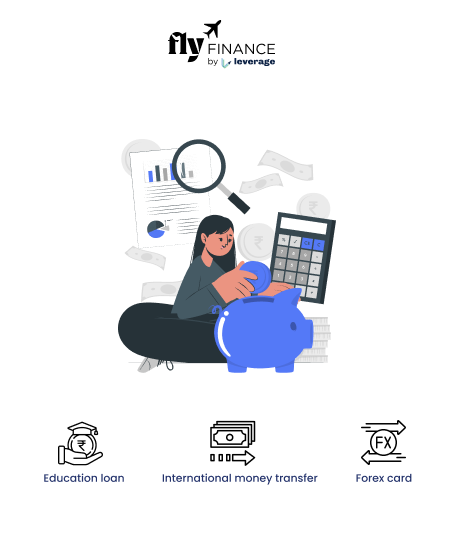Most education loans in India were offered based on the marginal cost of funds. However, it was replaced with a new system that considers external factors for interest rate calculation, which introduced EBLR. The full form of EBLR in banking is ‘External Benchmark linked Lending Rate’. It is the rate at which most commercial banks consider external market factors like repo rates and T-bills for their calculation. Read this blog to find out more about EBLR.
Table of contents
What is the full form of EBLR?
The full form of EBLR is ‘External Benchmark linked Lending Rate’ which refers to the interest rate offered by the banks for loans to customers. It’s a system adopted by Indian banks to determine interest rates on loans, including education loan interest rates.
EBLR replaces the Marginal Cost of Funds-based Lending Rate (MCLR) or base rate to set interest rates. It considers external factors like the RBI repo rate to offer a Repo-linked Loan Lending Rate (RLLR). This aims to bring more transparency and consistency to loan interest rates across different banks.
Also Read: Having a gap after higher studies for entrance preparations or career building? Check out the details about obtaining a gap certificate for an education loan.
What is EBLR?
EBLR is one of the factors based on which banks determine loan interest rates, including education loans. They are linked to external market factors like the repo rate set by the RBI, treasury bill rate, or any other benchmark published by Financial Benchmarks India Pvt. Ltd.
It means that EBLR considers repo rates and T-bill rates as external factors that affect the lending interest rates. Besides these, other factors like credit risk premium (CRP), spread, and government directives affect EBLR rates. Let’s look at these factors in detail.
Factors Affecting EBLR
Repo-Rate- This is the rate at which the RBI lends money to commercial banks. When the repo rate goes up, banks have to pay more to borrow money, which can lead them to raise the EBLR to maintain their profit margins. Conversely, a decrease in the repo rate can lead to a lower EBLR.
Treasury Bills- T-bills are short-term debt instruments issued by the government that have an impact on the repo rate. They do not directly affect the EBLR rates. Higher T-bill yields indicate a tighter liquidity situation in the market. To manage inflation and control the money supply, the RBI might raise the repo rate in response to high T-bill yields.
Credit Risk Premium- This is the additional interest rate that banks charge borrowers based on their perceived creditworthiness. While not directly impacting the EBLR itself, it can affect the overall interest rate you pay on your education loan (EBLR + Credit Risk Premium). A borrower with a good credit history might qualify for a lower credit risk premium, resulting in a lower overall interest rate.
Also Read: Comparing education loan interest rates is one of the best practices before applying for a loan with any lender. Compare the education loan interest rates of leading banks and NBFCs to find the best-suited lender.
EBLR vs MCLR vs RLLR
The full form of MCLR is the Marginal Cost of Funds based Lending Rate and the full form of RLLR is the Repo-linked Loan Lending Rate.
While MCLR is the internal rate set by the banks, EBLR is based on external factors. RLLR-based loans are a part of EBLR. Thus, a majority of the difference lies between EBLR and MCLR.
| MCLR | EBLR (which considers RLLR) |
| It uses the marginal cost of funds, operating costs, and tenor premium for loan interest rate calculation. | It considers external factors like the repo rate set by the RBI, treasury bill rate, or any other benchmark published by Financial Benchmarks India Pvt. Ltd. |
| It was introduced in 2016 that replace the base rate system and aimed to improve the transmission of monetary policy. | It was introduced in 2019 that replace the MCLR system to further the transmission of monetary policy. |
| MCLR is revised monthly. | EBLR is revised every three months. |
EBLR of Various Banks
By now we know that EBLR rates are linked to external factors like repo rates and treasury bills. Most banks that have ELBR considering the repo rate have their EBLR set at 6.50%. This is because the current repo rate in India is 6.50% which was announced on 7th June 2024. EBLR linked to treasury bills (or T-bills) have a higher ELBR (eg- 6.90% for PNB Bank).
| Bank Name | EBLR |
| State Bank of India | 9.15%+CRP+BSP |
| ICICI Bank | 9.25% |
| Canara Bank | 6.50% (linked to repo-rate) |
| Punjab National Bank | 6.50% (linked to repo-rate) 6.90% (linked to treasury bill) |
| Axis Bank | 6.50% (linked to repo rate) |
This was all about the full form of EBLR. International students need to know about EBLR-based loans as most banks like Canara, PNB, and Axis Bank have interest charges on education loans based on EBLR.
FAQs
The full form of EBLR is ‘External Benchmark linked Lending Rate’. It is a commonly used term in banks when they grant loans. It refers to the interest rate offered by the banks for loans to customers.
EBLR is the External Benchmark Lending Rate. It is the rate at which most commercial banks like Canara Bank, PNB, SBI, and ICICI lend out loans to customers. These rates consider external market factors like repo rate and T-bills for its calculation.
EBLR considers external factors like the RBI repo rate and treasury bills for its calculation. This is why it is known as the External Benchmark Lending Rate. This aims to bring more transparency and consistency to loan interest rates across different banks.
Most banks that have ELBR considering the repo rate have their EBLR set at 6.50%. This is because the current repo rate in India is 6.50% which was announced on 7th June 2024. EBLR linked to treasury bills (or T-bills) have a higher ELBR (eg- 6.90% for PNB Bank).
Factors that affect EBLR calculation are repo rate, T-bills, credit risk premium, spread, and government directives.
To know more about forex cards, education loans, the best bank accounts for students, and banking experience for global students or international money transfers, reach out to our experts at 1800572126 to help ease your study abroad experience.
| Related Blogs | |
| Full Form of CIBIL | Full Form of NBFC |
| Full Form of KYC | Full Form of POS |
| Full Form of NPA | Full Form of PAN |
| Full Form of CIF | Full Form of EMI |
| Full Form of NACH | Full Form of DPD |
Follow Us on Social Media





























